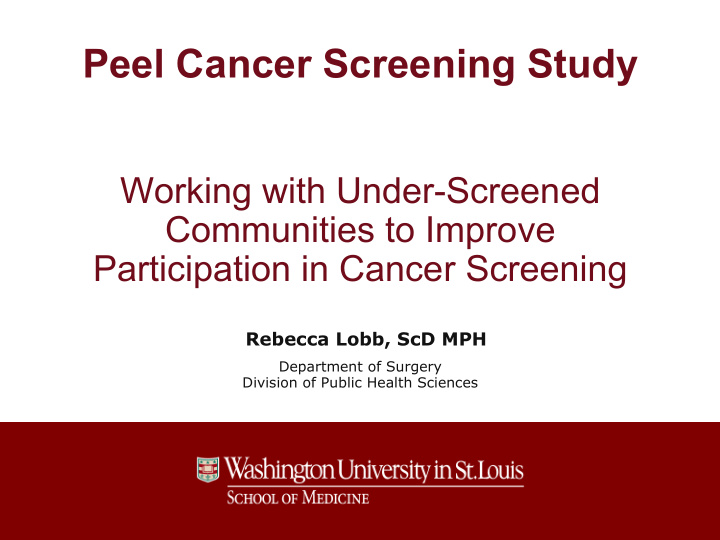



Peel Cancer Screening Study Working with Under-Screened Communities to Improve Participation in Cancer Screening Rebecca Lobb, ScD MPH Department of Surgery Division of Public Health Sciences
Goal of Study To examine ways to promote use of research-tested interventions that can increase cancer screening among under screened populations Department of Surgery Division of Public Health Sciences
Goal of Presentation Describe strategies to adapt research-tested interventions with stakeholders to increase cancer screening among South Asians in the Peel region of Ontario organizations residents Department of Surgery Division of Public Health Sciences
Project Team and Advisory Group Organization Stakeholder Representation St. Michael ’ s Hospital Researchers Cancer Care Ontario Provincial Overseer of Cancer Screening Peel Public Health Regional Public Health Punjabi Community Health Services Community Service Organization Canadian Cancer Society National Cancer Society Bramalea Community Health Centre East Mississauga Community Health Centre Health Service Organizations Peel Regional Cancer Program Primary Care Physician from Solo Practice Brampton Civic Hospital Aurat Health Services Canadian Association of Multi-Cultural People Community Service Organizations Brampton Multicultural Community Centre Malton Neighbourhood Services Department of Surgery Division of Public Health Sciences
Background Under-screened populations in Canada and Ontario include immigrant • and ethnic minority populations Immigrants from South Asia have lower rates of breast and cervical • cancer screening South Asians were the top visible minority group in Canada in 2006 • The Peel Region of Ontario: • Population ~1.2 million • 50% self-identify as visible minority • South Asians largest visible minority group • Department of Surgery Division of Public Health Sciences
Research-Tested Interventions Research-tested interventions have undergone sufficient testing to suggest they work! Increase demand for cancer screening among residents Client reminders Printed, telephone Small media conveys educational or Printed, video motivational information Group education Lecture, interactive, lay or professional educator One-to-one education Telephone, face-to-face, lay or professional educator Reduce structural barriers Convenient hours, translation, transportation Increase recommendations from health professionals Feedback on Performance For a group of providers or individuals, compared to goal or standard Reminders Generated electronically, manually Department of Surgery Division of Public Health Sciences
Identify Local Barriers – Concept Mapping Participants: • Male and Female South Asian residents English, Punjabi, & Urdu , primary care physicians, community service organizatons, health service organizations Rating surveys: Importance of barriers to Mammogram, Pap test, FOBT use Feasibility of addressing barriers Department of Surgery Division of Public Health Sciences
Research-Tested Interventions Reminders Client Media Small Education Group Education one One-to- Barriers Structural Reduce Costs Reduce Feedback Provider Reminder Provider Barriers Health System C C C C C C C Ethno-cultural C discordance C C C C C Costs Education Programs C C C C C C Client beliefs, fears, lack of social support Limited client C C C C C knowledge Limited health care C C provider knowledge Department of Surgery Division of Public Health Sciences
Assess Local Resources Geographic Information Systems Organizational Network Analysis Department of Surgery Division of Public Health Sciences
Adapt Evidence-Based Interventions Logic Model OUTCOMES (change in) INPUTS ACTIVITIES OUTPUTS Short- Medium- Long- Department of Surgery Division of Public Health Sciences
Cultivate Relationships – Advisory Group • On-going communication in-person and by phone • Articulate a common agenda for change • Share experiences to inform decisions • Organizations contribute what they do best • Participatory decision making • Resolve conflicts Department of Surgery Division of Public Health Sciences
Challenges How to integrate residents ’ perspectives on an on-going basis How to develop shared measurement systems for ongoing self-evaluation How to sustain resource streams for intervention activities and adaptation of intervention in response to changes in context Department of Surgery Division of Public Health Sciences
Summary Research-tested interventions need to be adapted for program participants and the organizations that will implement the interventions Using visual representations of complex data with knowledge exchange can promote a shared understanding of the issues and solutions Participatory research methods to adapt research-tested interventions can encourage ownership among program implementers We need more implementation research to realize the return on investment that has been made in discovery science Department of Surgery Division of Public Health Sciences
Recommend
More recommend